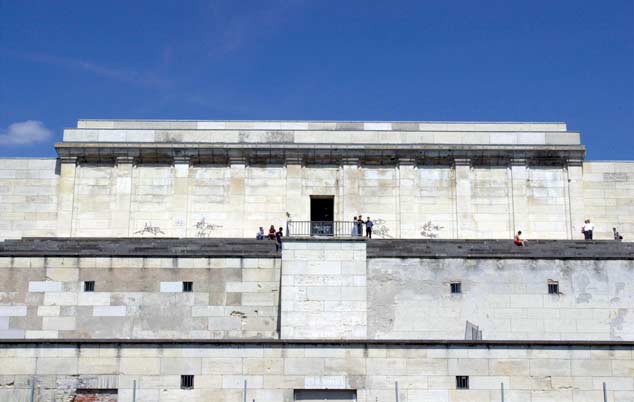
Even today, the remaining structures of the Nazi Party Rally Grounds still dominate a large section of the urban landscape in southeastern Nuremberg. The way in which the city has dealt with the former Nazi Party Rally Grounds and their structures has gone through several phases over the past 65 years and more. The first decades after 1945 were characterized by a mixture of perplexity, ignorance, psychological repression, and sheer pragmatism. The new democracy had little use for such structures, whose only purpose had been as propaganda for the National Socialist regime. This phase includes car races, sports events, uses for storage, as well as the demolition of dilapidated and unfinished parts of buildings.
A reconception began only after the amended Bavarian Monument Protection Act of 1973 placed the structures of the former Nazi Party Rally Grounds under protection. The former silence gradually gave way to keeping and preserving the structures, in combination with teaching about the history of Nazism. The establishment of a first exhibition, "Fascination and Terror" – kept rather simple because of a lack of funds – at the Zeppelintribüne in 1985 was a crucial step toward using the site more fully as a way of teaching history. The exhibition was limited to summer months and the building was already in questionable condition, yet interest from visitors all over the world was rising. So in 2001, the former location was replaced with the opening of a contemporary permanent exhibition at the Documentation Center in the former Congress Hall. The guidelines for the city's future treatment of the former Nazi Party Rally Grounds, adopted unanimously by the City Council in 2004, linked the preservation of the buildings with an educational mission. From now on, a task force of various municipal agencies is to address concerns that involve the site as a whole.
Today, the question of adequate treatment of the Nazi Party Rally Grounds has arisen once again. The Zeppelintribüne and Zeppelinfield especially, more than seventy years after they were built, are structurally troubled. Without prompt, skilled restoration, this site for historical and civic education could be totally lost within a few years. A concept paper prepared in 2011 by the City of Nuremberg's Task Force on the former Nazi Party Rally Grounds, dealing with how to treat the Zeppelinfield educational site, was approved that October by a large majority of the Culture Committee of the City Council. It establishes a number of guidelines for further procedure:
- The structural integrity of the Zeppelinfield and Zeppelintribüne is to be preserved.
- The vivid presence, informative depth and autonomous experience of the Zeppelintribüne as a historical site serve to counteract both mystification and trivialization of its era.
- Temporary artistic engagement with the structural relics on the grounds opens up new options for access and understanding. For artistic uses, a concept will be developed for the entire former Nazi Party Rally Grounds, using the Zeppelintribüne and the Zeppelinfield as core components and venues.
- Everyday uses and leisure events are an integral part of a contemporary handling of National Socialist propaganda architecture, deliberately opposing the enforced conformity of National Socialist events with opportunities for individualized growth and development. But this can apply only if the structural effect of the buildings is not permanently compromised (for example, by booths, fences, etc.).
A November 2011, a conference of specialists, titled "Conservation or Deterioration?" was held at the Documentation Center, where experts from Germany and elsewhere explored the future treatment of the Zeppelinfield from the perspectives of education, cultural studies, tourism, and preservation of historical monuments. More than 100 participants took advantage of the opportunity to talk with experts at the site about the prospects for preservation and concepts for future uses. The event was covered by the national press. Both the experts and the public agreed in supporting preservation of the Zeppelintribüne facility.
Zeppelin Field – A Place for Learning
A Project to Maintain a Very Special National Heritage
(pdf file 6 MB)
You can find more information (in German) about the future of the Nazi Party Rally Grounds at:
Künftiger Umgang mit dem Reichsparteitagsgelände
Nuremberg in Brussels
On March 1, 2018, Nuremberg Mayor Dr. Ulrich Maly and other VIPs from politics and culture represented the Free State of Bavaria before the EU in Brussels, urging the need to deal critically together with Europe's history of violence in the 20th century, arguing for forward-looking work in historico-political education, and explaining the contribution Nuremberg can make in light of the crisis in the EU. A lively discussion with their audience also concerned what role the Culture of Remembrance should play as a part of Nuremberg's application to become a Capital of Culture.



